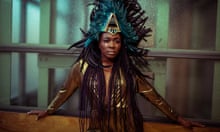In times of economic and political crisis popular culture tends to turn to the fantastical, providing an escape from the harsh realities of life. However, what is usually represented as Utopian in mainstream science fiction is often culturally European with a story that frequently revolves around a white male character. Even when depicting "multiracial" future societies, culturally the tropes of that imagined culture are regularly not representative of the races seen. If we accept that all humanity will be present in the future, why is it that non-European cultures seem to disappear once we get through the Earth’s atmosphere?
In 1993, Mark Dery created the term Afrofuturism to describe science fiction by African-American writers such as Samuel R Delany and Octavia Butler, whose work "treats African-American themes and addresses African-American concerns in the context of 20th century technoculture and, more generally, African-American signification that appropriate images of technology and a prosthetically enhanced future". The term is now used to describe works that explore black experience in the science-fiction genre. However the ideas and aesthetics that form Afrofuturism go back further than the work of these authors, with Afrofuturist elements being found in music, art and film. Afrofuturism also goes beyond spaceships, androids and aliens, and encompasses African mythology and cosmology with an aim to connect those from across the Black Diaspora to their forgotten African ancestry.
If there was ever a figure who was the embodiment of Afrofuturism it would be Jazz musician, Sun Ra, although to place him within the borders of a musical genre does not do him justice as an artist. With no legal birth certificate, it is believed he was born in the Jim Crow state of Alabama. Sun Ra created a mythical, ethereal persona that merged science fiction with Egyptian mysticism, producing an otherworldliness that matched the music he made from the 50s to his death in 1993. Adding to his legend, he also claimed to not be of this Earth, explaining:
I never wanted to be a part of planet Earth, but I am compelled to be here, so anything I do for this planet is because the Master-Creator of the Universe is making me do it. I am of another dimension. I am on this planet because people need me.
When one considers the social position of African-Americans during this period and their violent exclusion from society, leading to an overwhelming sense of otherness, believing oneself to be from Saturn doesn’t seem that far-fetched. In fact, it expertly communicates the confusion and alienation of the black male experience in 20th century America.
A musical son of Sun Ra, George Clinton, concocted a world of outlandish fictional characters with his groups Funkadelic and Parliament. Continuing the alienation narrative created by Sun Ra, in Clinton’s P-Funk musical mythology African-Americans needed the "Mothership Connection" which brought to them the holy Funk (the source of life) so they could make the journey to their true home in outer space. Again incorporating Egyptian mysticism, the P-Funk characters Starchild and Doctor Funkenstein hid information about the true source of the universe in the pyramids until mankind was mentally and spiritually ready to receive it. Afrofuturistic themes can also be seen in the music of Afrikan Bambattaa, Janelle Monae, Outkast, Ras G and more.
Not all Afrofuturist works are as colourful, outlandish and, well, funky. Said to be the first science fiction novel by an African-American, George Schuyler’s Black No More is a satirical look at race relations in 1930s America. An African-American doctor invents a serum that removes all pigmentation from the body, making those who are black appear white. In a society divided by shade, Schuyler shines a light on how economic power is constructed and kept by a small white male elite. Reluctantly associated with the Harlem Renaissance, Schuyler showed no fear in sending up African-American political icons such as W E B Dubois and Booker T Washington or exposing the internal race and class politics of African America. If you want to read more on this, P Djeli Clark examines Schulyer’s changing cultural and political phases in his piece Diesel Punk: Myth and Metaphor.
In the Art world, Ellen Gallagher – who last year had her first major solo exhibition in the UK at Tate Modern – creates images that touch upon the idea of a mythical Black Atlantis. Manipulating and transforming images from vintage black hair adverts of the past, she gives them new meanings in futuristic settings freeing them from the social constructions of beauty present at their time. We can also see Afrofuturism in Africa with Kenyan director Wanuri Kahiu’s short film Pumzi, which explores a post-apocalyptic future where water scarcity and a poisonous atmosphere have destroyed all of nature and forced humans to live underground and rely on renewable energy.
Afrofuturism creates a space for those from the Black Diaspora to explore issues in the present and how they will manifest in the future. As Michah Yongo points out, just as the language used in Orwell’s 1984 has been used to frame the debate around increasing government surveillance, black science fiction can provide a new language to address the increasingly complicated frameworks of discrimination. If we are able to name these frameworks in the same way we recognise Big Brother when we see him, it is the first step in being able to dismantle them. In this sense, Afrofuturism provides a lot more to the black experience than simple escapism, silver Dashikis and pyramid-shaped spaceships, although I will always have time for that too.
You can read more on this topic by following Media Diversified's series on Afrofuturism.
Chardine Taylor-Stone is the founder of black speculative fiction book club Mothership Connections (@MCBookClub on Twitter). She is a member of Writers of Colour, plays drums in black feminist punk band Big Joanie and is currently in her final year studying for a BA (Hons) Arts and Humanities at Birkbeck










Comments (…)
Sign in or create your Guardian account to join the discussion